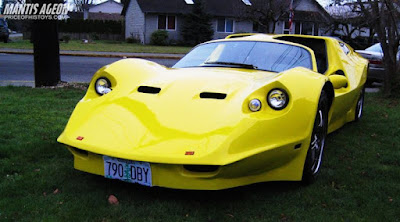Visionary Craft - Sometimes, the rarest treasures aren’t found behind velvet ropes or glass cases—but hidden in garages, built with bare hands, a vision, and a bit of mud. Long before sleek supercars became commonplace, a man named David Loring dreamed up wild, futuristic shapes that felt more like spaceships than road cars. Among his creations, one car in particular stands out—not just for its rarity, but for the story it tells: the Loring Design Mantis Aegean.
 |
| An impossibly low-slung silhouette with sweeping curves—this rare Mantis Aegean looks more like a concept car than a kit car, capturing the essence of Loring’s futuristic vision. (Picture from: Pinterest) |
The Mantis Aegean looks like it leapt straight out of a sci-fi film. Low, wide, and dramatically sculpted, its shape turns heads and raises eyebrows in equal measure. It's a car that doesn’t whisper for attention—it demands it. With its curvaceous yellow fiberglass body hugging impossibly low to the ground, flush headlights, muscular arches, and sculpted air vents, the Mantis Aegean is less a kit car and more an art piece on wheels. At just 37.5 inches tall, it feels closer in size to a go-kart than a road car, but with the presence of a full-blown exotic. The rear is capped with louvered panels, adding a hint of retro charm and functionality, while its flowing bodywork gives it a silhouette unlike anything else on the road—even today.
And that uniqueness isn’t just visual. The story of the Mantis Aegean is deeply tied to the passion and determination of its creator. David Loring wasn’t a traditional car builder. He started on an entirely different path—studying pre-med, attending Howard University, serving in the U.S. Army, and eventually ending up at the Art Center in Los Angeles. It was there that his creativity found an unusual outlet: building fiberglass sports car bodies, often from nothing more than a few sketches and a lot of determination.
 |
| A close look at the front reveals sharp detailing and wide-set proportions, giving the Mantis Aegean an unmistakable presence that’s part racer, part rolling sculpture. (Picture from: FiberClassics.org) |
In a modest workshop in Sausalito, California, Loring sculpted his dream cars using wood frames, paint scrapers, and even sticky, smelly clay dug from the San Francisco Bay. What emerged weren’t just cars, but completely original designs that defied the boxy norms of the era. His cars weren’t trying to copy European exotics—they were something else entirely, often looking decades ahead of their time.
The Mantis Aegean was one of several models he built under the Loring Design name, including the Mantis Targa, Frog Pickup, Wedgeaero, and Gezelle. But the Aegean—whether in coupe or targa form—is arguably the most dramatic of them all. Built as a kit car, it was meant to be assembled by enthusiasts, allowing them to build something truly unique. Only two are known to exist today, making it one of the rarest pieces of automotive history hiding in plain sight.
 |
| From this angle, the bold rear haunches and sculpted bodylines show off the Mantis Aegean’s aggressive stance—an unapologetic design that defies era and expectation. (Picture from: Pinterest) |
Unfortunately, Loring’s path wasn’t without its setbacks. According to Fiberclassics.org, his highly original designs began to draw the attention of others—some of whom chose to borrow rather than create. Well-known figures in the kit car world, such as Jim Kellison, Bruce Weeks, and Roy Kaylor, are said to have taken inspiration a step too far, incorporating elements of Loring’s work and marketing them under different names. One notable example is the Kaylor Invader GT-5, which appears to be little more than a rebranded Mantis, produced years after Loring’s original creation.
Today, the remaining Mantis Aegeans are more than collector’s items—they’re conversation starters, rolling sculptures, and testaments to pure imagination. One of the known examples, originally labeled as a 1975 model, has undergone a variety of repairs and tweaks, including the addition of a dual-carb 1600 engine once found in a WWII Kubelwagen, and a 240Z-style louvered rear panel to cover the wide-open rear hatch. Despite not being in pristine shape, it still has the power to amaze anyone lucky enough to see it on the street. | jcWLd8Jxt_U |
 David Loring may not have become a household name, but his vision lives on in these striking, unforgettable cars. With the original molds reportedly still in his possession, there’s a flicker of possibility that more Mantis Aegeans could one day be born. But for now, the few that exist remain a secret among kit car enthusiasts and dreamers—each one a bold reminder of what happens when design meets daring. *** [EKA | FROM VARIOUS SOURCES | FIBERCLASSICS.ORG | ALLCARINDEX ]
David Loring may not have become a household name, but his vision lives on in these striking, unforgettable cars. With the original molds reportedly still in his possession, there’s a flicker of possibility that more Mantis Aegeans could one day be born. But for now, the few that exist remain a secret among kit car enthusiasts and dreamers—each one a bold reminder of what happens when design meets daring. *** [EKA | FROM VARIOUS SOURCES | FIBERCLASSICS.ORG | ALLCARINDEX ]Note: This blog can be accessed via your smart phone.
